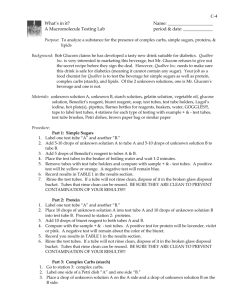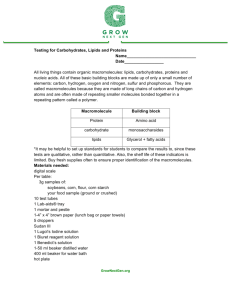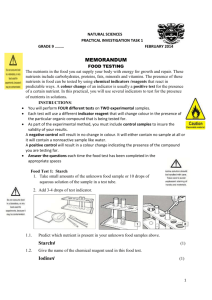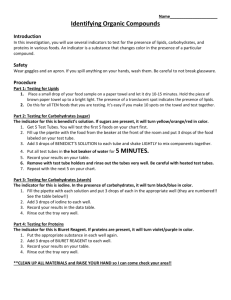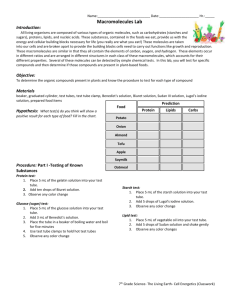Lesson 11 - LAB - Testing for Macromolecules
advertisement
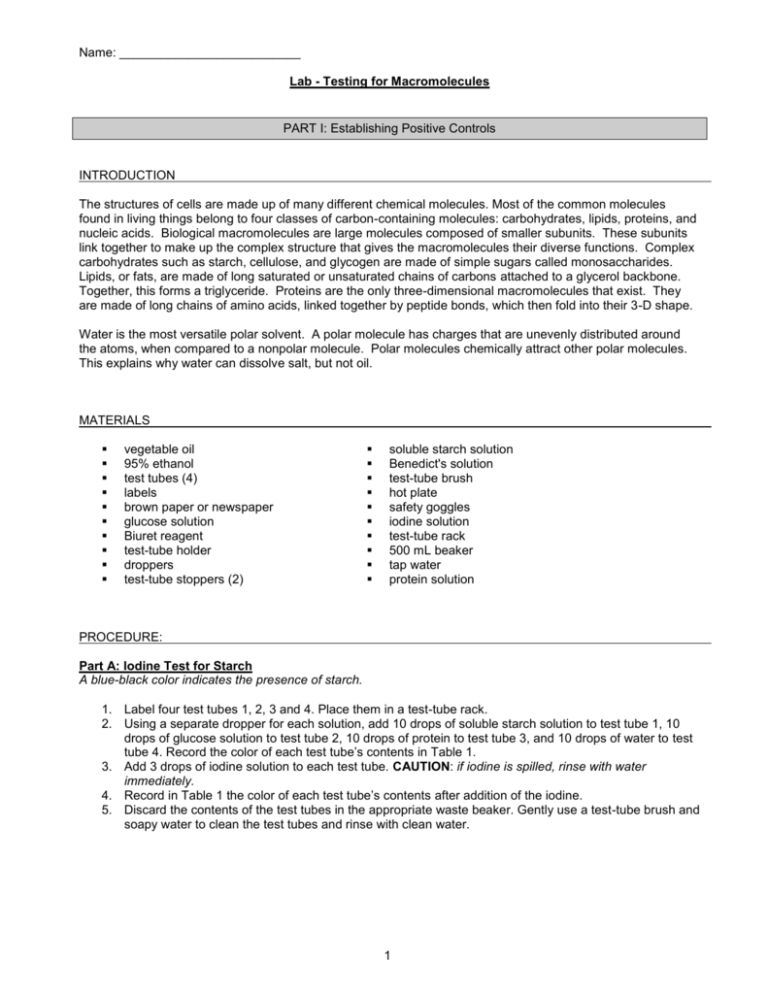
Name: __________________________ Lab - Testing for Macromolecules PART I: Establishing Positive Controls INTRODUCTION The structures of cells are made up of many different chemical molecules. Most of the common molecules found in living things belong to four classes of carbon-containing molecules: carbohydrates, lipids, proteins, and nucleic acids. Biological macromolecules are large molecules composed of smaller subunits. These subunits link together to make up the complex structure that gives the macromolecules their diverse functions. Complex carbohydrates such as starch, cellulose, and glycogen are made of simple sugars called monosaccharides. Lipids, or fats, are made of long saturated or unsaturated chains of carbons attached to a glycerol backbone. Together, this forms a triglyceride. Proteins are the only three-dimensional macromolecules that exist. They are made of long chains of amino acids, linked together by peptide bonds, which then fold into their 3-D shape. Water is the most versatile polar solvent. A polar molecule has charges that are unevenly distributed around the atoms, when compared to a nonpolar molecule. Polar molecules chemically attract other polar molecules. This explains why water can dissolve salt, but not oil. MATERIALS vegetable oil 95% ethanol test tubes (4) labels brown paper or newspaper glucose solution Biuret reagent test-tube holder droppers test-tube stoppers (2) soluble starch solution Benedict's solution test-tube brush hot plate safety goggles iodine solution test-tube rack 500 mL beaker tap water protein solution PROCEDURE: Part A: Iodine Test for Starch A blue-black color indicates the presence of starch. 1. Label four test tubes 1, 2, 3 and 4. Place them in a test-tube rack. 2. Using a separate dropper for each solution, add 10 drops of soluble starch solution to test tube 1, 10 drops of glucose solution to test tube 2, 10 drops of protein to test tube 3, and 10 drops of water to test tube 4. Record the color of each test tube’s contents in Table 1. 3. Add 3 drops of iodine solution to each test tube. CAUTION: if iodine is spilled, rinse with water immediately. 4. Record in Table 1 the color of each test tube’s contents after addition of the iodine. 5. Discard the contents of the test tubes in the appropriate waste beaker. Gently use a test-tube brush and soapy water to clean the test tubes and rinse with clean water. 1 Part B: Benedict’s Test for Reducing Sugars Benedict’s solution tests for the presence of simple reducing sugars. This means you can detect monosaccharides and some disaccharides, but not polysaccharides. Thus, a color change may or may not occur when Benedict’s solution is added to a carbohydrate and heated. A change from blue to green, yellow, orange, or red occurs if a monosaccharide or some disaccharides are present. The most drastic changes occur with high concentrations of monosaccharides. The original blue color will remain after heating if a polysaccharide or some disaccharides are present. 1. For a water bath, heat 250 ml of water to boiling using med-high heat on the hot plate. 2. Label four test tubes 1, 2, 3 and 4. 3. Using a separate dropper for each solution, add 10 drops of soluble starch solution to test tube 1, 10 drops of glucose solution to test tube 2, 10 drops of protein to test tube 3, and 10 drops of water to test tube 4. 4. Record the color of each test tube’s contents in Table 2. 5. Add 20 drops of Benedict’s solution to each tube and place them in a boiling water bath for 3 minutes. 6. Remove the test tubes from the water bath using a test-tube holder and place them in a test-tube rack to cool. CAUTION: Be careful not to burn yourself. If Benedict’s solution is spilled, rinse with water immediately. 6. Record the color of each tube’s contents in Table 2. 7. Discard the contents of the test tubes in the appropriate waste beaker. Gently use a test-tube brush and soapy water to clean the test tubes and rinse with clean water. Part C: Spot Test for Lipids If a semitransparent spot is evident, the sample contains lipids. 1. 2. 3. 4. Place a drop of water on a piece of brown paper or newspaper. In a separate spot on your brown paper, place a drop of oil. Allow the paper to dry for a few minutes. You may need to use a paper towel to dab off excess. Hold the piece of paper up to the light. Record the appearance of the two spots in Table 3. Part D: Solubility Test for Lipids Lipids are soluble only in nonpolar solvents because lipids themselves are nonpolar. If the mixture looks a little cloudy and does not separate after a minute, then it is soluble. 1. 2. 3. 4. 5. 6. Make sure the test tubes are completely dry before you begin. Label two test tubes 1 and 2. Using separate droppers, add 20 drops of oil to test tube 1 and 20 drops of 95% ethanol to test tube 2. Add 10 drops of water to test tubes 1 and 2 and stopper each tube. Shake each tube gently and let it settle, and record in Table 4 whether water dissolves either solute. Dispose of the contents of the test tubes in the appropriate waste beaker. Gently use a test-tube brush and soapy water to clean the two test tubes and rinse with clean water. Part E: Biuret Test for Proteins When Biuret reagent is mixed with a protein, it will produce a lavender to violet color. The greater the colour change, the more protein present in the sample. 1. Label three test tubes 1, 2, and 3. 2. Using separate droppers, add 30 drops of glucose solution to test tube 1, 30 drops of protein solution to test tube 2, and 30 drops of water to test tube 3. Record the color of each tube’s contents in Table 5. 3. Add 10 drops of Biuret reagent to each test tube. CAUTION: Biuret reagent is extremely caustic to the skin and clothing. If Biuret reagent spills, rinse with water immediately. 4. Record in Table 5 the color of each tube’s contents after adding the Biuret reagent. 5. Discard the contents of the test tubes into the appropriate waste beaker. Gently use a test-tube brush and soapy water to clean the test tubes and rinse with clean water. 6. Fill in the last column of all five tables with the correct interpretation of the test results. 2 OBSERVATIONS Table 1. Iodine Test for Starch Test Tube Substance 1 Starch 2 Glucose 3 Protein 4 Water Colour Before Colour After Presence of Starch (+/-) (─) indicates a negative test result (i.e., the substance being tests for was not present) (+) indicates a positive test result (i.e., the substance being tests for was present) Table 2. Benedict’s Test for Reducing Sugars Test Tube Substance 1 Starch 2 Glucose 3 Protein 4 Water Table 3. Spot Test for Lipids Substance Colour Pre-Boiling Colour PostBoiling Presence of Sugar (+/-) Table 4. Solubility Test for Lipids Presence of Lipids (+/-) Translucent? Substance Water Oil Oil Ethanol Dissolves? Presence of Lipids (+/-) Table 5. Biuret Test for Proteins Test Tube Substance 1 Glucose 2 Protein 3 Water Colour Before 3 Colour After Presence of Proteins (+/-) PART II: Testing for Unknowns Using your data from Part I, you will now work to identify unknown macromolecules in various samples. PROCEDURE 1. Obtain 20 mL of unknown sample #1. Make sure the solution has been stirred. 2. Place 3 mL of unknown sample #1 in each of four test tubes labeled 1a-1d. 3. Add 3 drops of iodine solution to test tube 1a. Using the positive controls you established in Part I (refer to Table 1), determine whether this sample contains starch. Record your results for the presence of starch in Table 6, indicating either a positive result (+) or a negative result (–). 4. Add 20 drops of Benedict’s solution to test tube 1b. Place this test tube in a hot water bath for 3 minutes. Remove the test tube from the water bath using a test-tube holder and place it in the test-tube rack to cool. CAUTION: Be careful not to burn yourself. Using the positive controls from Part I (refer to Table 2), determine whether this sample contains glucose. Record your results for the presence of reducing sugars in Table 6. 5. In test tube 1c, carefully add 10 drops of water. Place a stopper on the test tube. Shake the test tube gently, and let it settle. Using the positive controls from Part I (refer to Table 4), determine whether this sample contains lipids. Record your results for the presence of lipids in Table 6. 6. Add 10 drops of Biuret reagent to test tube 1d. Using the positive controls you established in Part I (refer to Table 5), determine whether this sample contains proteins. Record your results for the presence of proteins in Table 6. 7. Dispose of the contents of test tubes 1a-1d as instructed by your teacher. Clean the test tubes using soapy water, and thoroughly dry each test tube before proceeding. 8. Obtain 20 mL of unknown sample #2. Again, make sure the sample has been stirred. Label four clean test tubes 2a-2d. Using the clean test tubes, repeat steps 2-7 for sample #2. Be sure to record all of your results for sample #2 in the appropriate spaces in Table 6. 9. Obtain 20 mL of unknown sample #3. Again, make sure the sample has been stirred. Label four clean test tubes 3a-3d. Using the clean test tubes, repeat steps 2-7 for sample #3. Be sure to record all of your results for sample #3 in the appropriate spaces in Table 6. 10. Obtain 20 mL of unknown sample #4. Again, make sure the sample has been stirred. Label four clean test tubes 4a-4d. Using the clean test tubes, repeat steps 2-7 for sample #4. Be sure to record all of your results for sample #4 in the appropriate spaces in Table 6. 4 OBSERVATIONS Table 6. Data Table for Unknown Samples Unknown Sample # Tests 1 a Starch b Glucose c Lipids d Proteins 2 3 4 – indicates a negative test result (i.e., the substance being tested for was not present) + indicates a positive test result (i.e., the substance being tested for was present) ANALYSIS 1. Based on the results you recorded in Table 6, determine the macromolecule in each of the five unknown samples. (4 marks) Unknown Sample #1: _________________________________________ Unknown Sample #2: _________________________________________ Unknown Sample #3: _________________________________________ Unknown Sample #4: _________________________________________ 2. Why was water tested in each of the tests for Day 1? (2 marks) 3. Biuret reagent will turn the skin and fingernails a brownish-purple colour. Explain why. (3 marks) 4. When greasy food is spilled, why is it difficult to clean with water alone? How should grease spills be cleaned (other than using plain water)? Include a description of water’s properties that apply. (4 marks) 5. List 2 characteristics that carbohydrates, lipids, and proteins have in common. (4 marks) 6. Describe the reaction that forms macromolecules such as carbohydrates, lipids, and proteins. Are these reactions anabolic or catabolic? (4 marks) 7. Explain why triglycerides are not considered polymers. (3 marks) 8. Differentiate between organic and inorganic molecules. (3 marks) 5


